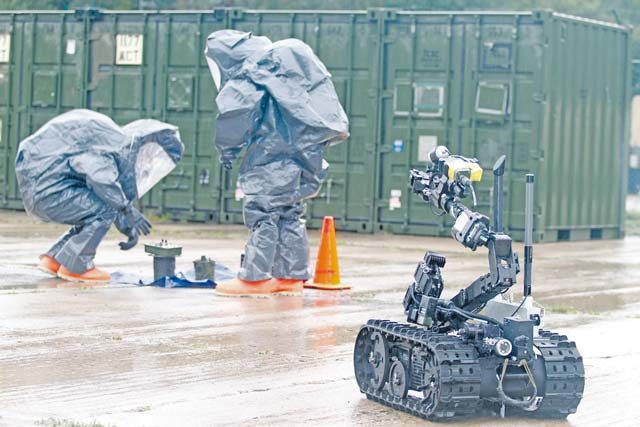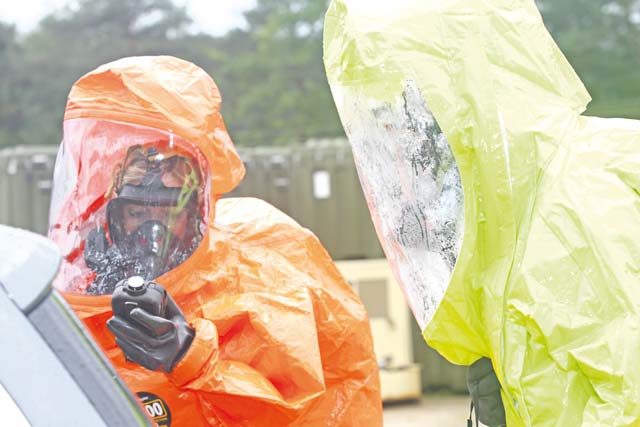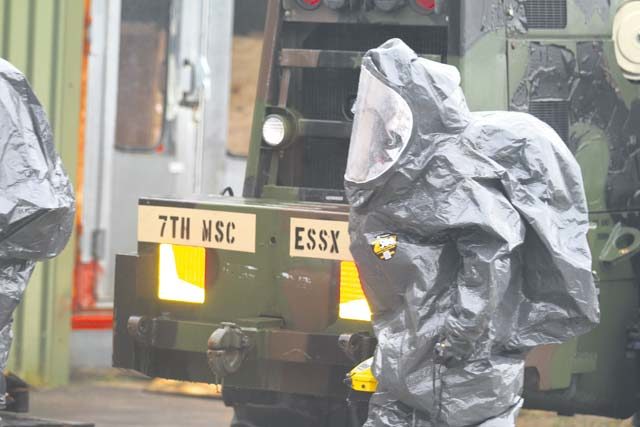
Under rainy skies, on an early fall morning better suited for sleeping in, Army Reserve Soldiers of the 773rd Civil Support Team, 7th Mission Support Command, responded to an alert on Daenner Kaserne, Sept. 14.
The team donned specialized protective gear, deployed sensor equipment and released robots for a simulated contamination threat during an important certification exercise.
Col. U. L. Armstrong, the commander of the 773rd CST, said the alert was a test of the readiness of his troops to provide a unique early emergency response for the special types of dangers which can threaten the lives of Soldiers and civilians.
“It will be full-spectrum CST operations,” Armstrong said.
Armstrong explained that his Soldiers are skilled in detecting and locating chemical, biological, radiological and nuclear hazards and to provide higher echelons with information to decide the best course of action in the event of site contamination.
To validate the technical proficiency of the unit, Department of the Army civilian observers experienced in civil and military CBRN emergencies also took part in the exercise.
“They are assessed by how quick they can alert, assess, upload and go to a site and identify chemical, biological or radioactive materials,” said John Nonemaker, Deputy Director of the U.S. Army North Civil Support Training Team based in San Antonio, Texas.
Nonemaker said a 90 percent surety rate in the classification of CBRN contamination is expected of the civil support teams.
He added, the certification is required every 18 months to ensure proficiency and skills. His team evaluates all 58 CSTs in the Army, but the 773rd CST is the only one in Europe, and in the Army Reserve. The other 57 are in the National Guard.
Army Staff Sgt. Shawn M. McKenna, a CBRN Team Chief with the 773rd CST said his and other teams have an array of equipment and analytic resources on which to rely.
“They’ll be able to identify basically what type of hazard it is,” he said.


McKenna said when his team moves out in their distinctive protective suits and sensor-arrayed robots, it’s their job to find out as much as possible about the location and type of hazard using scientific measurement and analysis.
The missions can have their dangers. McKenna and other team members balance the mission of gathering data with personal safety.
Teamwork is essential, because the air in their closed-circuit breathing systems and sealed suits is limited.
“They’re constantly keeping us on track for monitoring air,” said McKenna of the mission control elements located safely at the perimeter of the contaminated site, connected with the team by radio.
McKenna explained that when the air runs out for the team on site, a relief team is already suited up to continue the mission, wherever that may be, until the hazard is located and identified.
“We could be crawling in tunnels … you name it, we go there,” McKenna said.


